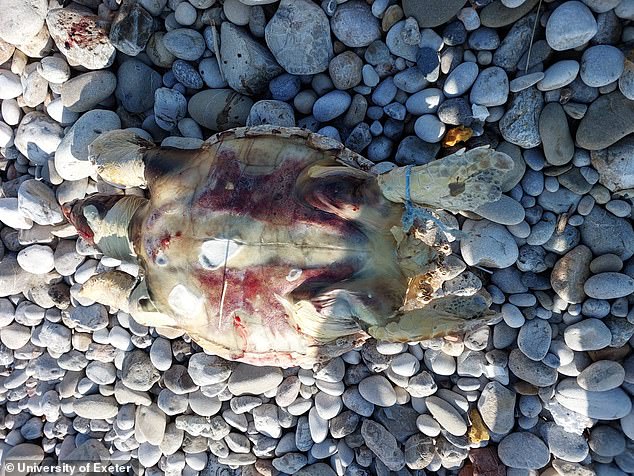- Scientists analyzed the guts of dead sea turtles in the Mediterranean
- They found hundreds of plastic items, including a Halloween toy featuring a witch’s finger.
<!–
<!–
<!– <!–
<!–
<!–
<!–
Heartbreaking new images have highlighted the devastating impact of the Earth’s plastic pollution.
Scientists who analyzed the guts of dead sea turtles in the Mediterranean discovered hundreds of plastic objects.
This includes bottle caps, gum wrappers, and even a Halloween toy with a rubber witch finger.
“The journey of that Halloween toy – from a child’s costume to the inside of a sea turtle – is a fascinating insight into the life cycle of plastic,” said study lead author Dr. Emily Duncan of the University of Exeter.
“These turtles feed on gelatinous prey, such as jellyfish, and seafloor prey, such as crustaceans, and it’s easy to see how this object might have looked like a crab claw.”

Scientists who analyzed the guts of dead sea turtles in the Mediterranean discovered hundreds of plastic objects. This includes bottle caps, gum wrappers and even a rubber Halloween toy with a witch’s finger (pictured).


In the study, researchers examined 135 loggerhead turtles that had been dragged or killed as bycatch in fishing nets in northern Cyprus.
In the study, researchers examined 135 loggerhead turtles that had been dragged or killed as bycatch in fishing nets in northern Cyprus.
An analysis of its insides revealed that more than 40 percent contained large pieces of plastic, known as macroplastics.
In total, the study found 492 pieces of macroplastic, 67 of them in a single turtle.
“The plastics we found were largely in sheet form (62%), transparent (41%) or white (25%) and the most common polymers identified were polypropylene (37%) and polyethylene (35%),” he said. Dr. Duncan.
“Turtles likely ingest plastics that mostly look very similar to their food.”


In total, the study found 492 pieces of macroplastic in the turtles’ guts, including a whopping 67 in one turtle.


“The plastics we found were largely sheet (62%), transparent (41%) or white (25%) and the most common polymers identified were polypropylene (37%) and polyethylene (35%),” said Dr. Duncan.
The worrying thing is that researchers say they still don’t know all the impacts of macroplastics on turtle health.
“Negative effects could include blockages and limitation of nutrition,” Dr. Duncan added.
While the study highlights the devastating impact of the Earth’s plastic pollution on sea turtles, experts say more research is now needed.
“Much larger sample sizes will be needed for the loggerhead sea turtle to be an effective ‘bioindicator’ species,” said study co-author Professor Brendan Godley.
“We recommend that studies also include green turtles, which will allow for a more holistic picture.”
The news comes shortly after images revealed how hermit crabs are increasingly forced to live in our garbage.


While the study highlights the devastating impact of the Earth’s plastic pollution on sea turtles, experts say more research is now needed.
Experts from the University of Warsaw analyzed online photographs taken by wildlife enthusiasts and recorded 386 individuals using “artificial shells.”
It is not yet clear whether this new behavior is harmful to the creatures, which need “armor” to protect their soft abdomen.
Professor Marta Szulkin said: ‘In the photographs, we discovered a total of 386 individuals using ‘artificial shells’, mainly plastic caps, but also made from broken necks of glass bottles or metal ends of light bulbs.
‘According to our calculations, 10 of the 16 species of land hermit crabs in the world use this type of shelter.
“This unusual behavior is observed in all tropical regions of the Earth.”

